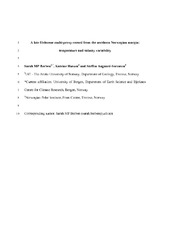| dc.contributor.author | Berben, Sarah Miche Patricia | |
| dc.contributor.author | Husum, Katrine | |
| dc.contributor.author | Sørensen, Steffen Aagaard | |
| dc.date.accessioned | 2017-04-27T12:41:52Z | |
| dc.date.available | 2017-04-27T12:41:52Z | |
| dc.date.issued | 2016 | |
| dc.Published | Berben S, Husum kat, Sørensen SA. A late-Holocene multi-proxy record from the northern Norwegian margin: Temperature and salinity variability. The Holocene. 2016 | eng |
| dc.identifier.issn | 0959-6836 | en_US |
| dc.identifier.uri | https://hdl.handle.net/1956/15729 | |
| dc.description.abstract | To elucidate the natural variability of Atlantic and Coastal water, a late-Holocene multi-proxy analysis is performed on a marine sediment core from the northern Norwegian margin. This includes planktic foraminiferal fauna and their preservation indicators, stable isotopes (δ18Oc, δ13C), sub-surface temperature (SSTMg/Ca) and salinity (SSS) records based on paired Mg/Ca and δ18Oc measurements of Neogloboquadrina pachyderma and transfer function–derived sub-surface temperatures (SSTTransfer). The record shows a general cooling with subtle fluctuating palaeoceanographic conditions, here attributed to shifting North Atlantic Oscillation (NAO) modes. Period I (ca. 3500–2900 cal. yr BP) is strongly influenced by Coastal water and stratified water masses, possibly correlating to negative NAO conditions. During period II (ca. 2900–1600 cal. yr BP), dominating warm Atlantic water might be linked to a positive NAO mode and the Roman Warm Period. A renewed influence of Coastal water is observed throughout period III (ca. 1600–900 cal. yr BP). Stable and colder SST values potentially correlate to the Dark Ages and are here attributed to negative NAO conditions. Within period IV (ca. 900–550 cal. yr BP), the core site experienced a stronger influence of Atlantic water which might be because of the positive NAO conditions correlating to the ‘Medieval Warm Period’. Additionally, an inverse correlation in Atlantic water influence between the eastern and western Atlantic Ocean is observed throughout periods II, III and IV. This Atlantic oceanographic see-saw pattern is attributed to an opposite climatic response to changing NAO conditions arguing for a coupling between ocean and atmosphere. | en_US |
| dc.language.iso | eng | eng |
| dc.publisher | SAGE | en_US |
| dc.subject | Atlantic water influence | eng |
| dc.subject | Coastal water | eng |
| dc.subject | late-Holocene | eng |
| dc.subject | multi-proxy record | eng |
| dc.subject | NAO | eng |
| dc.subject | northern Norwegian margin | eng |
| dc.title | A late-Holocene multi-proxy record from the northern Norwegian margin: Temperature and salinity variability | en_US |
| dc.type | Journal article | |
| dc.date.updated | 2017-03-09T08:42:05Z | |
| dc.description.version | submittedVersion | en_US |
| dc.rights.holder | Copyright 2016 The Author(s) | en_US |
| dc.identifier.doi | https://doi.org/10.1177/0959683616675934 | |
| dc.identifier.cristin | 1402918 | |
| dc.source.journal | The Holocene | |
| dc.relation.project | EU: 238111 | |
